The Cambridge History of Japan, Vol. 3: Medieval Japan
Подождите немного. Документ загружается.

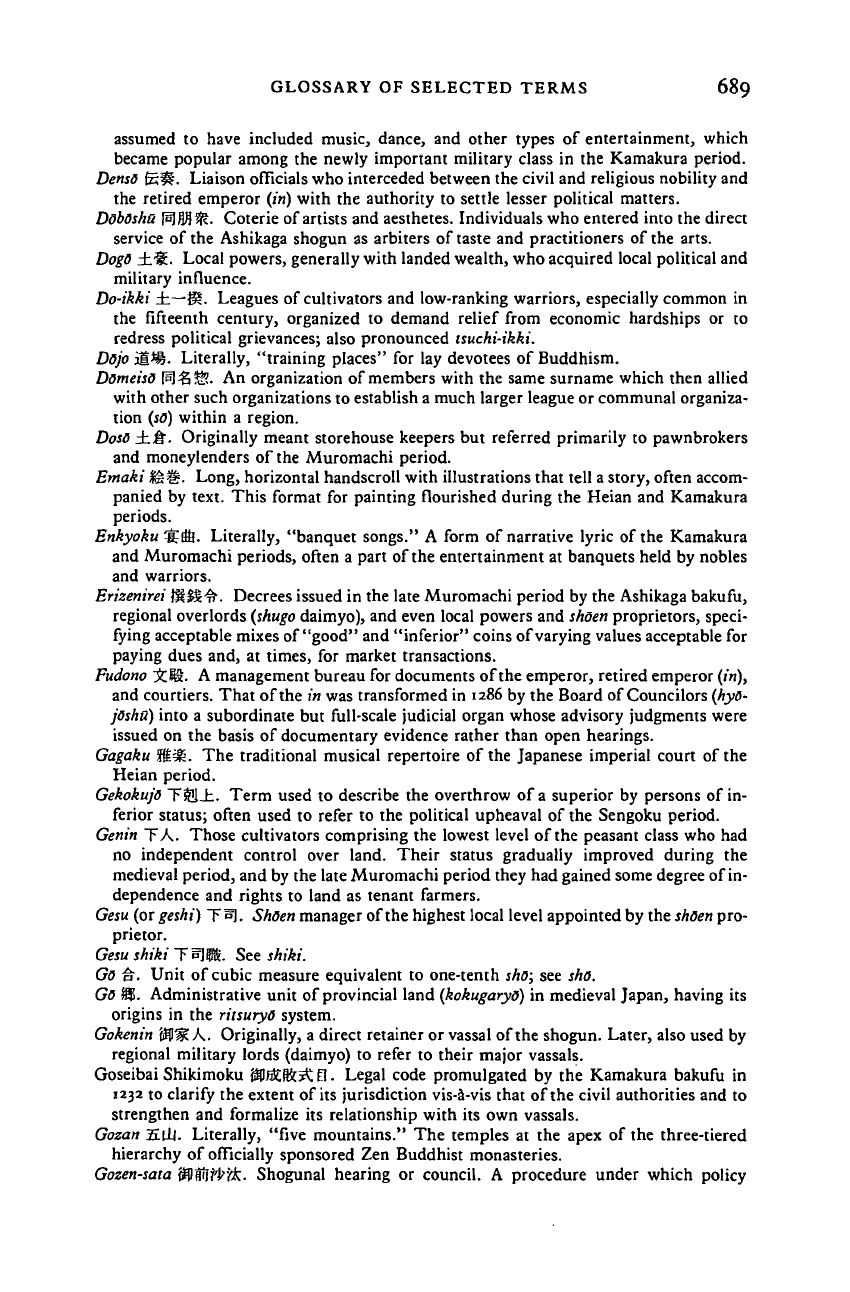
GLOSSARY OF SELECTED TERMS 689
assumed to have included music, dance, and other types of entertainment, which
became popular among the newly important military class in the Kamakura period.
DensO
f5H. Liaison officials who interceded between the civil and religious nobility and
the retired emperor (in) with the authority to settle lesser political matters.
DdbSsha
IBJIW^?.
Coterie of artists and aesthetes. Individuals who entered into the direct
service of the Ashikaga shogun as arbiters of taste and practitioners of the arts.
DogO
±.%L.
Local powers, generally with landed wealth, who acquired local political and
military influence.
Do-ikki ±—JH. Leagues of cultivators and low-ranking warriors, especially common in
the fifteenth century, organized to demand relief from economic hardships or to
redress political grievances; also pronounced tsuchi-ikki.
Dojo
38*!§.
Literally, "training places" for lay devotees of Buddhism.
DomeisO
Wi%>?&.
An organization of members with the same surname which then allied
with other such organizations to establish a much larger league or communal organiza-
tion
(so)
within a region.
Doso
±.M. Originally meant storehouse keepers but referred primarily to pawnbrokers
and moneylenders of the Muromachi period.
Emaki
|K#.
Long, horizontal handscroll with illustrations that tell a story, often accom-
panied by text. This format for painting flourished during the Heian and Kamakura
periods.
Enkyoku tffi. Literally, "banquet songs." A form of narrative lyric of the Kamakura
and Muromachi periods, often a part of the entertainment at banquets held by nobles
and warriors.
Erizenirei JiHt^. Decrees issued in the late Muromachi period by the Ashikaga bakufu,
regional overlords
(shugo
daimyo), and even local powers and
shoen
proprietors, speci-
fying acceptable mixes of "good" and "inferior" coins of varying values acceptable for
paying dues and, at times, for market transactions.
Fudono
jilt. A management bureau for documents of the emperor, retired emperor (in),
and courtiers. That of the in was transformed in 1286 by the Board of Councilors
(hyO-
joshti) into a subordinate but full-scale judicial organ whose advisory judgments were
issued on the basis of documentary evidence rather than open hearings.
Gagaku Jt=£. The traditional musical repertoire of the Japanese imperial court of the
Heian period.
Gekokujo
T3BLL. Term used to describe the overthrow of a superior by persons of in-
ferior status; often used to refer to the political upheaval of the Sengoku period.
Genin TA. Those cultivators comprising the lowest level of the peasant class who had
no independent control over land. Their status gradually improved during the
medieval period, and by the late Muromachi period they had gained some degree of in-
dependence and rights to land as tenant farmers.
Gesu
(or
geshi)
T^l.
ShOen
manager of the highest local level appointed by the
shoen
pro-
prietor.
Gesu shiki
TBIB.
See shiki.
Go ef. Unit of cubic measure equivalent to one-tenth she; see sho.
Go #$. Administrative unit of provincial land
(kokugaryO)
in medieval Japan, having its
origins in the
ritsuryO
system.
Gokenin M%K. Originally, a direct retainer or vassal of the shogun. Later, also used by
regional military lords (daimyo) to refer to their major vassals.
Goseibai Shikimoku $)fi£BJC5£ 0 • Legal code promulgated by the Kamakura bakufu in
1232 to clarify the extent of its jurisdiction vis-a-vis that of the civil authorities and to
strengthen and formalize its relationship with its own vassals.
Gozan Eli). Literally, "five mountains." The temples at the apex of the three-tiered
hierarchy of officially sponsored Zen Buddhist monasteries.
Gozen-sata 'MwiWlk. Shogunal hearing or council. A procedure under which policy
Cambridge Histories Online © Cambridge University Press, 2008
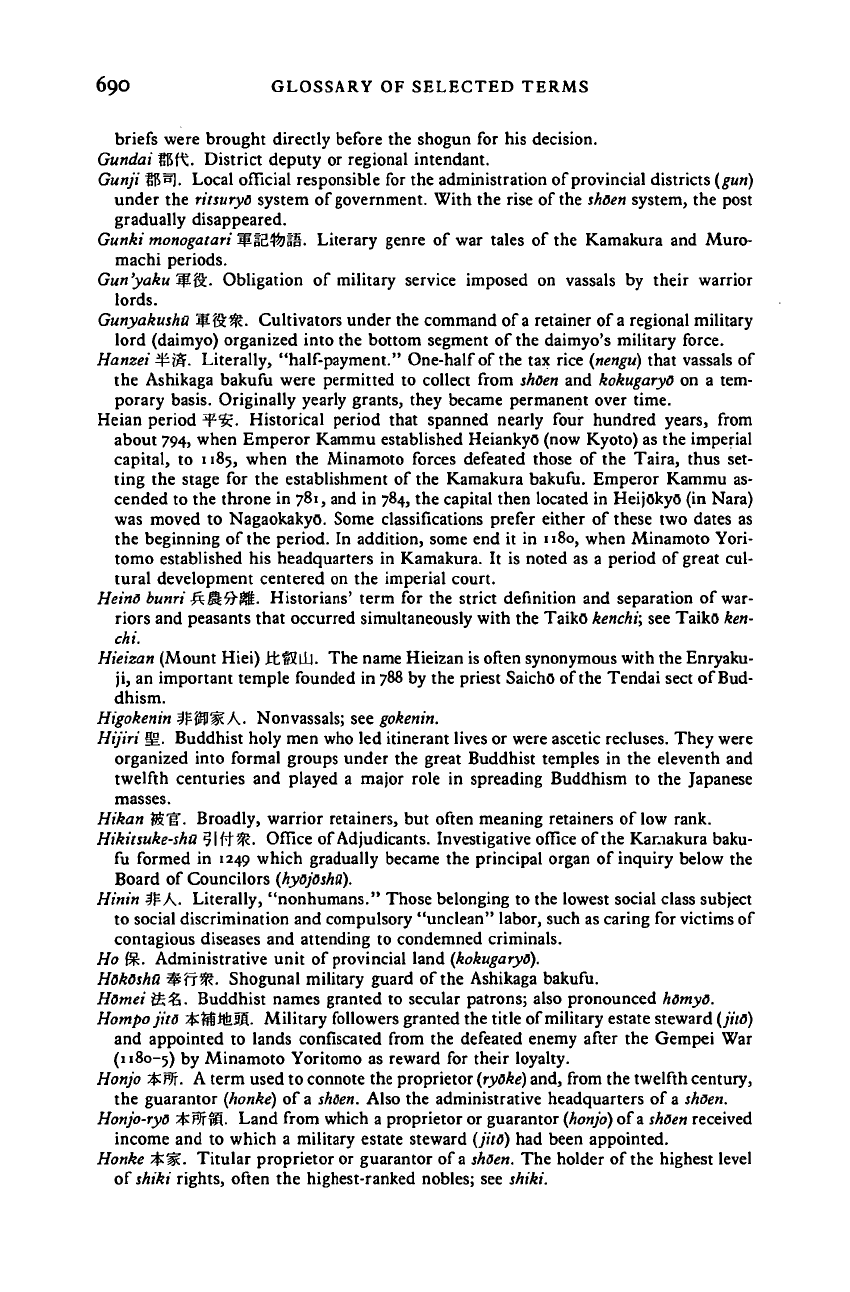
69O GLOSSARY
OF
SELECTED TERMS
briefs were brought directly before
the
shogun
for his
decision.
Gundai fBft. District deputy
or
regional intendant.
Gunji fRW). Local official responsible
for the
administration of provincial districts (gun)
under
the
ritsuryo system
of
government. With
the
rise
of
the
shoen
system,
the
post
gradually disappeared.
Gunki monogatari WS5.$)ia. Literary genre
of war
tales
of the
Kamakura
and
Muro-
machi periods.
Gun'yaku
W-'&-
Obligation
of
military service imposed
on
vassals
by
their warrior
lords.
Gunyakushtt
W€t%£-
Cultivators under
the
command of a retainer
of
a
regional military
lord (daimyo) organized into
the
bottom segment
of
the daimyo's military force.
Hanzei
¥i%-
Literally, "half-payment." One-half
of
the
tax
rice
(nengu)
that vassals
of
the Ashikaga bakufu were permitted
to
collect from shoen
and
kokugaryO
on a tem-
porary basis. Originally yearly grants, they became permanent over time.
Heian period ^'S:. Historical period that spanned nearly four hundred years, from
about 794, when Emperor Kammu established HeiankyO (now Kyoto)
as the
imperial
capital,
to 1185,
when
the
Minamoto forces defeated those
of the
Taira, thus
set-
ting
the
stage
for the
establishment
of
the Kamakura bakufu. Emperor Kammu
as-
cended
to the
throne
in
781,
and in
784,
the
capital then located
in
HeijOkyO
(in
Nara)
was moved
to
NagaokakyO. Some classifications prefer either
of
these
two
dates
as
the beginning
of
the period.
In
addition, some
end it in
1180, when Minamoto Yori-
tomo established
his
headquarters
in
Kamakura.
It is
noted
as a
period
of
great
cul-
tural development centered
on the
imperial court.
Heino bunri
£k§kft%fc-
Historians' term
for the
strict definition
and
separation
of
war-
riors
and
peasants that occurred simultaneously with
the
TaikO
kertchi;
see
TaikO ken-
chi.
Hieizan (Mount Hiei) itfKlil.
The
name Hieizan
is
often synonymous with
the
Enryaku-
ji,
an
important temple founded
in
788
by the
priest SaichO of the Tendai sect of Bud-
dhism.
Higokenin WWW.K. Nonvassals;
see
gokenin.
Hijiri
U.
Buddhist holy
men who led
itinerant lives
or
were ascetic recluses. They were
organized into formal groups under
the
great Buddhist temples
in the
eleventh
and
twelfth centuries
and
played
a
major role
in
spreading Buddhism
to the
Japanese
masses.
Hikan
Silf.
Broadly, warrior retainers,
but
often meaning retainers
of
low rank.
Hikitsuke-sha 'jlf+ffc. Office of Adjudicants. Investigative office of the Kamakura baku-
fu formed
in 1249
which gradually became
the
principal organ
of
inquiry below
the
Board
of
Councilors
(hyOjOsha).
Hinin 3$ A. Literally, "nonhumans." Those belonging
to the
lowest social class subject
to social discrimination
and
compulsory "unclean" labor, such
as
caring
for
victims
of
contagious diseases
and
attending
to
condemned criminals.
Ho
f£.
Administrative unit
of
provincial land
(kokugaryO).
HokOshn
WVLtR.-
Shogunal military guard
of
the Ashikaga bakufu.
Homei &.&. Buddhist names granted
to
secular patrons; also pronounced homyo.
Hompojito ^MJ&SI. Military followers granted
the
title of military estate steward (jito)
and appointed
to
lands confiscated from
the
defeated enemy after
the
Gempei
War
(1180-5)
by
Minamoto Yoritomo
as
reward
for
their loyalty.
Honjo
;£J9f. A
term used
to
connote
the
proprietor
(ryoke)
and, from
the
twelfth century,
the guarantor (honke)
of
a
shoen.
Also
the
administrative headquarters
of
a shoen.
Honjo-ryo ^fiftH. Land from which
a
proprietor
or
guarantor
(honjo)
of a
shoen
received
income
and to
which
a
military estate steward (jito)
had
been appointed.
Honke
~fcW..
Titular proprietor
or
guarantor
of
a
shoen.
The
holder
of
the highest level
of skiki rights, often
the
highest-ranked nobles;
see
shiki.
Cambridge Histories Online © Cambridge University Press, 2008
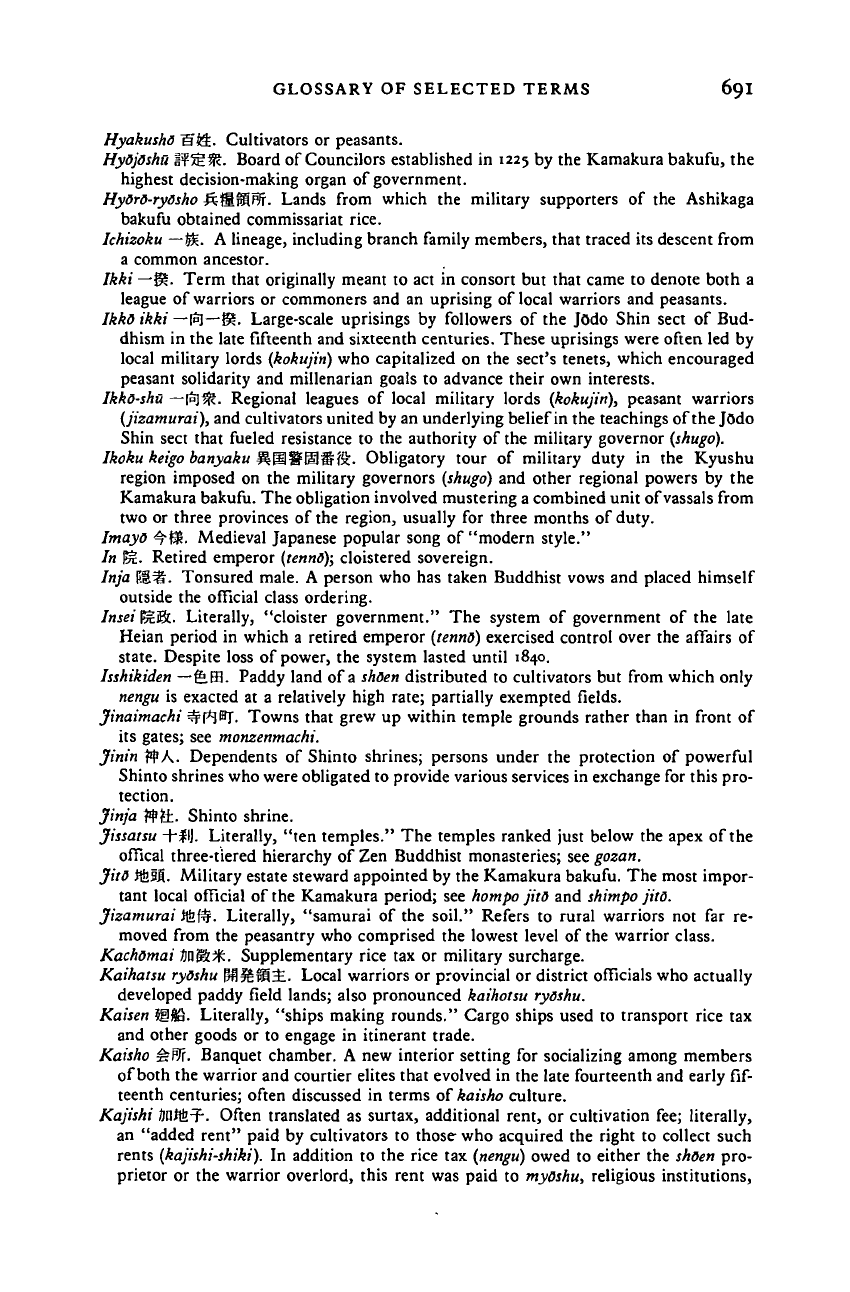
GLOSSARY OF SELECTED TERMS 69I
Hyakusho
~§t&.
Cultivators or peasants.
HyOjOshtt
WRL%.
Board of Councilors established in 1225 by the Kamakura bakufu, the
highest decision-making organ of government.
HyDrO-ryOsho
^UPSB?.
Lands from which the military supporters of the Ashikaga
bakufu obtained commissariat rice.
Ichizoku —
$£.
A lineage, including branch family members, that traced its descent from
a common ancestor.
Ikki — §|. Term that originally meant to act in consort but that came to denote both a
league of warriors or commoners and an uprising of local warriors and peasants.
Ikko ikki — |Sj—g|. Large-scale uprisings by followers of the Jodo Shin sect of Bud-
dhism in the late fifteenth and sixteenth centuries. These uprisings were often led by
local military lords (kokujin) who capitalized on the sect's tenets, which encouraged
peasant solidarity and millenarian goals to advance their own interests.
IkkO-shu
— (n)«S?. Regional leagues of local military lords (kokujin), peasant warriors
(jizamurai), and cultivators united by an underlying belief in the teachings of the Jodo
Shin sect that fueled resistance to the authority of the military governor
(shugo).
Ikoku
keigo
banyaku HEIIil@#f£. Obligatory tour of military duty in the Kyushu
region imposed on the military governors
(shugo)
and other regional powers by the
Kamakura bakufu. The obligation involved mustering a combined unit of vassals from
two or three provinces of the region, usually for three months of duty.
ImayO ^(S. Medieval Japanese popular song of "modern style."
In $k. Retired emperor
(tennO);
cloistered sovereign.
Inja
W.%.
Tonsured male. A person who has taken Buddhist vows and placed himself
outside the official class ordering.
Insei
ErcBt.
Literally, "cloister government." The system of government of the late
Heian period in which a retired emperor
(tennO)
exercised control over the affairs of
state. Despite loss of power, the system lasted until 1840.
hshikiden —feffi. Paddy land of a
shden
distributed to cultivators but from which only
nengu is exacted at a relatively high rate; partially exempted fields.
Jinaimachi #|*|BT. Towns that grew up within temple grounds rather than in front of
its gates; see monzenmachi.
Jinin t$A. Dependents of Shinto shrines; persons under the protection of powerful
Shinto shrines who were obligated to provide various services in exchange for this pro-
tection.
Jinja W±. Shinto shrine.
Jissatsu + JIJ. Literally, "ten temples." The temples ranked just below the apex of the
offical three-tiered hierarchy of Zen Buddhist monasteries; see gozan.
JitO Jfesl. Military estate steward appointed by the Kamakura bakufu. The most impor-
tant local official of the Kamakura period; see
hompo jitO
and
shimpo
jits.
Jizamurai Jtfif#. Literally, "samurai of the soil." Refers to rural warriors not far re-
moved from the peasantry who comprised the lowest level of the warrior class.
Kachomai Jn^:^. Supplementary rice tax or military surcharge.
Kaihatsu
ryOshu
[Jfl^giSi.. Local warriors or provincial or district officials who actually
developed paddy field lands; also pronounced kaihotsu
ryOshu.
Kaisen Wffi. Literally, "ships making rounds." Cargo ships used to transport rice tax
and other goods or to engage in itinerant trade.
Kaisho
&Wu
Banquet chamber. A new interior setting for socializing among members
of both the warrior and courtier elites that evolved in the late fourteenth and early fif-
teenth centuries; often discussed in terms of kaisho culture.
Kajishi SPJ&i
1
. Often translated as surtax, additional rent, or cultivation fee; literally,
an "added rent" paid by cultivators to those who acquired the right to collect such
rents (kajishi-shiki). In addition to the rice tax
(nengu)
owed to either the shoen pro-
prietor or the warrior overlord, this rent was paid to
myOshu,
religious institutions,
Cambridge Histories Online © Cambridge University Press, 2008
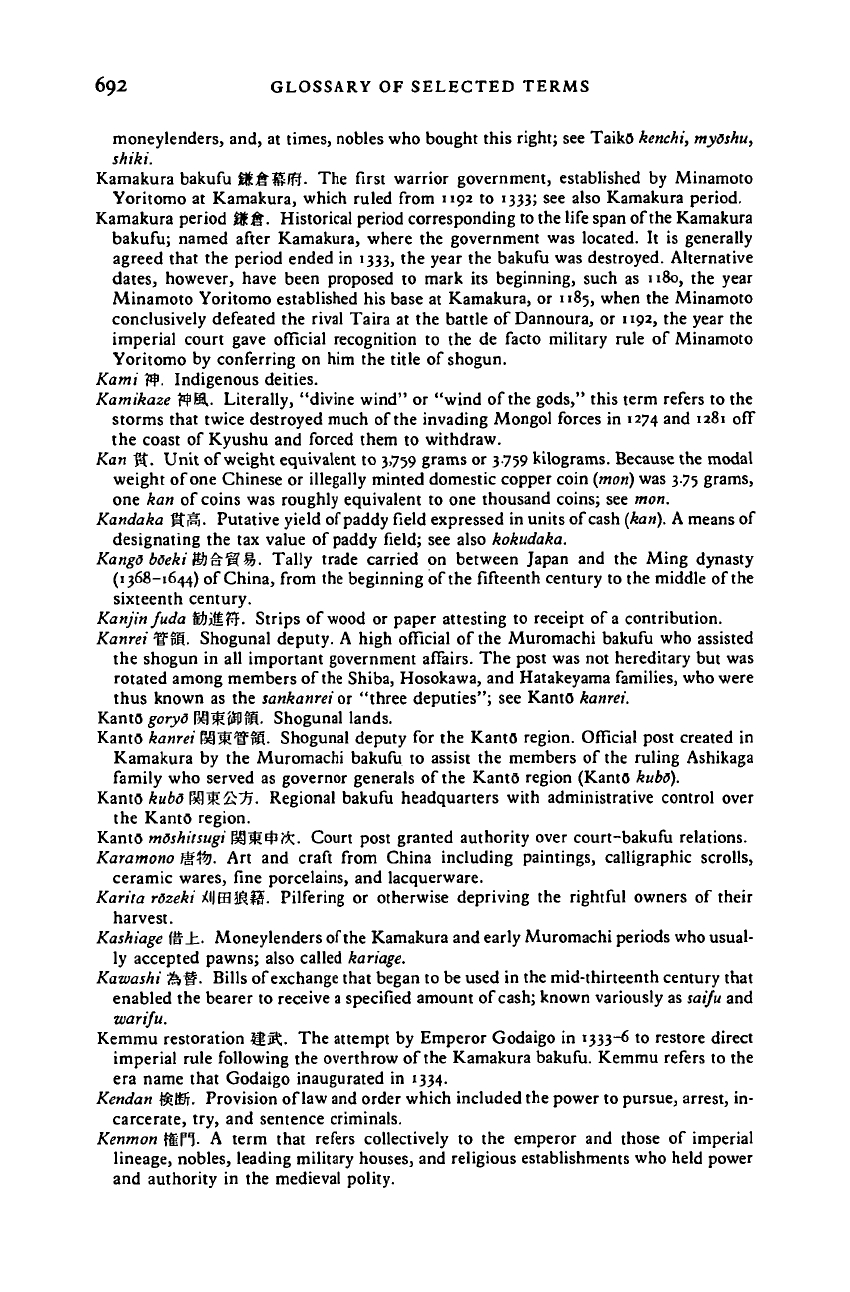
692 GLOSSARY OF SELECTED TERMS
moneylenders, and, at times, nobles who bought this right; see TaikO kenchi, myoshu,
shiki.
Kamakura bakufu flfc&SJl??. The first warrior government, established by Minamoto
Yoritomo at Kamakura, which ruled from 1192 to 1333; see also Kamakura period.
Kamakura period
JBfcJf.
Historical period corresponding to the life span of the Kamakura
bakufu; named after Kamakura, where the government was located. It is generally
agreed that the period ended in 1333, the year the bakufu was destroyed. Alternative
dates,
however, have been proposed to mark its beginning, such as 1180, the year
Minamoto Yoritomo established his base at Kamakura, or 1185, when the Minamoto
conclusively defeated the rival Taira at the battle of Dannoura, or 1192, the year the
imperial court gave official recognition to the de facto military rule of Minamoto
Yoritomo by conferring on him the title of shogun.
Kami }$. Indigenous deities.
Kamikaze ?$H.. Literally, "divine wind" or "wind of the gods," this term refers to the
storms that twice destroyed much of the invading Mongol forces in 1274 and 1281 off
the coast of Kyushu and forced them to withdraw.
Kan K. Unit of weight equivalent to 3,759 grams or 3.759 kilograms. Because the modal
weight of one Chinese or illegally minted domestic copper coin
(mori)
was 3.75 grams,
one kan of coins was roughly equivalent to one thousand coins; see mon.
Kandaka JltiSi. Putative yield of paddy field expressed in units of cash (kan). A means of
designating the tax value of paddy field; see also kokudaka.
Kangd bdeki ShaMfzi- Tally trade carried on between Japan and the Ming dynasty
(1368-1644) of China, from the beginning of the fifteenth century to the middle of the
sixteenth century.
Kanjin fuda ffliMffi. Strips of wood or paper attesting to receipt of a contribution.
Kanrei
UPI.
Shogunal deputy. A high official of the Muromachi bakufu who assisted
the shogun in all important government affairs. The post was not hereditary but was
rotated among members of
the
Shiba, Hosokawa, and Hatakeyama families, who were
thus known as the sankanrei or "three deputies"; see KantO kanrei.
KantOgoryd F^iKfflliS. Shogunal lands.
KantO kanrei K^ifSt. Shogunal deputy for the KantO region. Official post created in
Kamakura by the Muromachi bakufu to assist the members of the ruling Ashikaga
family who served as governor generals of the KantO region (KantO kubo).
KantO kubo
K^&TJ.
Regional bakufu headquarters with administrative control over
the KantO region.
KantO
mOshitsugi
$Q~Mfyft..
Court post granted authority over court-bakufu relations.
Karamono f§Vo. Art and craft from China including paintings, calligraphic scrolls,
ceramic wares, fine porcelains, and lacquerware.
Karita rozeki XI|EB3£f§. Pilfering or otherwise depriving the rightful owners of their
harvest.
Kashiage (S_h. Moneylenders of the Kamakura and early Muromachi periods who usual-
ly accepted pawns; also called kariage.
Kawashi &§. Bills of exchange that began to be used in the mid-thirteenth century that
enabled the bearer to receive a specified amount of cash; known variously as saifu and
war
ifu.
Kemmu restoration ^5^. The attempt by Emperor Godaigo in 1333-6 to restore direct
imperial rule following the overthrow of the Kamakura bakufu. Kemmu refers to the
era name that Godaigo inaugurated in 1334.
Kendan &Kr. Provision of law and order which included the power to pursue, arrest, in-
carcerate, try, and sentence criminals.
Kenmon fiFI- A term that refers collectively to the emperor and those of imperial
lineage, nobles, leading military houses, and religious establishments who held power
and authority in the medieval polity.
Cambridge Histories Online © Cambridge University Press, 2008
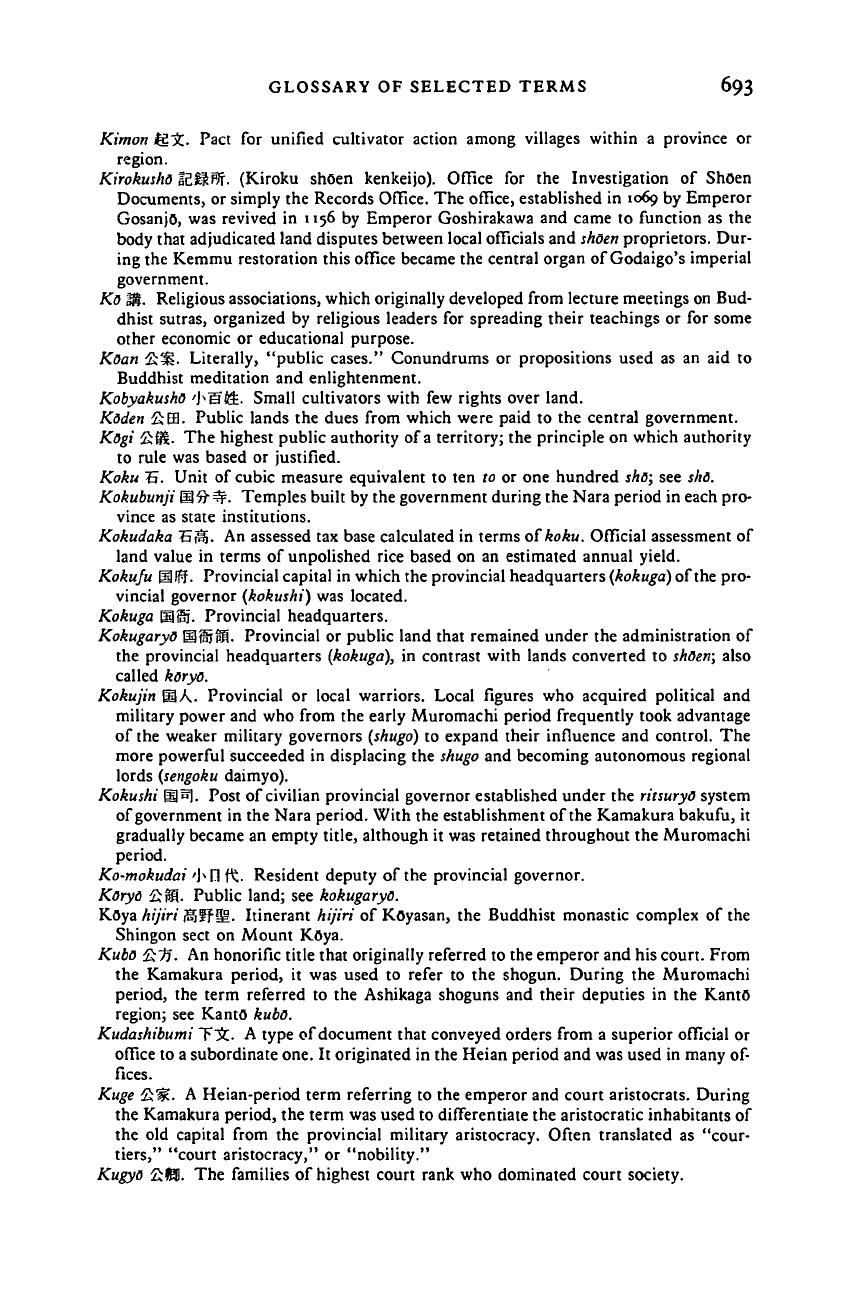
GLOSSARY OF SELECTED TERMS 693
Kimon |e It. Pact for unified cultivator action among villages within a province or
region.
Kirokusho
SgiSfff.
(Kiroku shOen kenkeijo). Office for the Investigation of ShOen
Documents, or simply the Records Office. The office, established in 1069 by Emperor
GosanjO, was revived in n 56 by Emperor Goshirakawa and came to function as the
body that adjudicated land disputes between local officials and
shoen
proprietors. Dur-
ing the Kemmu restoration this office became the central organ of Godaigo's imperial
government.
Ko s$. Religious associations, which originally developed from lecture meetings on Bud-
dhist sutras, organized by religious leaders for spreading their teachings or for some
other economic or educational purpose.
Koan fisg. Literally, "public cases." Conundrums or propositions used as an aid to
Buddhist meditation and enlightenment.
Kobyakusho 'Mf(&. Small cultivators with few rights over land.
Kdden fiffl. Public lands the dues from which were paid to the central government.
Kogi £91- The highest public authority of a territory; the principle on which authority
to rule was based or justified.
Koku
~G.
Unit of cubic measure equivalent to ten to or one hundred sho; see sho.
Kokubunji Slfr^. Temples built by the government during the Nara period in each pro-
vince as state institutions.
Kokudaka
5i8j.
An assessed tax base calculated in terms of koku. Official assessment of
land value in terms of unpolished rice based on an estimated annual yield.
Kokufu HU?. Provincial capital in which the provincial headquarters
(kokuga)
of the pro-
vincial governor (kokushi) was located.
Kokuga HSi. Provincial headquarters.
KokugaryO
Sfgrjil. Provincial or public land that remained under the administration of
the provincial headquarters (kokuga), in contrast with lands converted to
shoen;
also
called koryo.
Kokujin HA. Provincial or local warriors. Local figures who acquired political and
military power and who from the early Muromachi period frequently took advantage
of the weaker military governors
(shugo)
to expand their influence and control. The
more powerful succeeded in displacing the
shugo
and becoming autonomous regional
lords
(sengoku
daimyo).
Kokushi
IB],
Post of civilian provincial governor established under the ritsuryo system
of government in the Nara period. With the establishment of the Kamakura bakufu, it
gradually became an empty title, although it was retained throughout the Muromachi
period.
Ko-mokudai 'hflft. Resident deputy of the provincial governor.
KoryO fijS. Public land; see kokugaryO.
KOya hijiri iSfplg. Itinerant hijiri of KOyasan, the Buddhist monastic complex of the
Shingon sect on Mount KOya.
Kubo
ibCH.
An honorific title that originally referred to the emperor and his court. From
the Kamakura period, it was used to refer to the shogun. During the Muromachi
period, the term referred to the Ashikaga shoguns and their deputies in the Kanto
region; see KantO kubo.
Kudashibumi T3fc. A type of document that conveyed orders from a superior official or
office to a subordinate one. It originated in the Heian period and was used in many of-
fices.
Kuge Iz.%. A Heian-period term referring to the emperor and court aristocrats. During
the Kamakura period, the term was used to differentiate the aristocratic inhabitants of
the old capital from the provincial military aristocracy. Often translated as "cour-
tiers,"
"court aristocracy," or "nobility."
Kugyo £IED. The families of highest court rank who dominated court society.
Cambridge Histories Online © Cambridge University Press, 2008
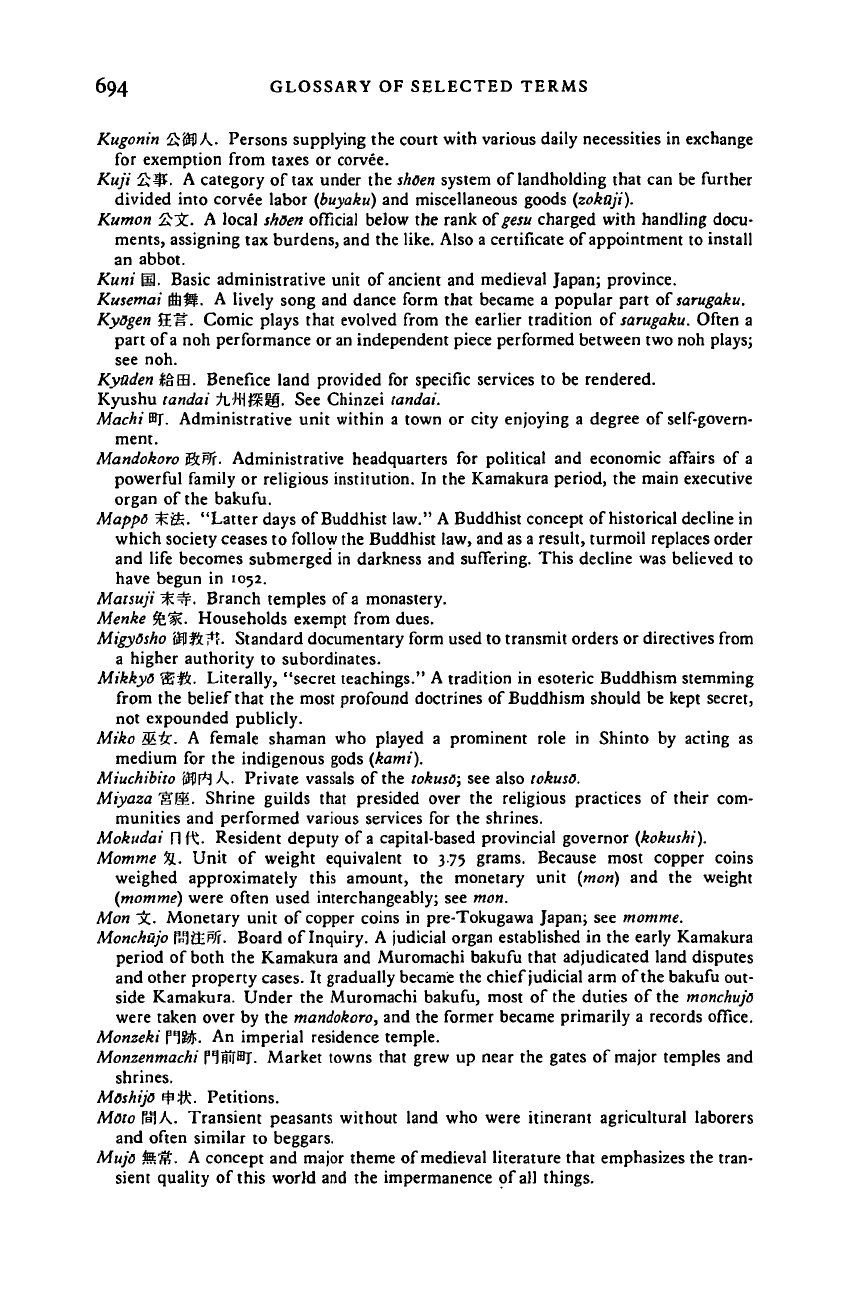
694 GLOSSARY OF SELECTED TERMS
Kugonin
£<$j)
A.
Persons supplying the court with various daily necessities in exchange
for exemption from taxes or corvee.
Kuji £V. A category of tax under the
shoen
system of landholding that can be further
divided into corvee labor (buyaku) and miscellaneous goods (zokaji).
Kumon &
JC.
A local
shoen
official below the rank ofgesu charged with handling docu-
ments,
assigning tax burdens, and the like. Also a certificate of appointment to install
an abbot.
Kuni B. Basic administrative unit of ancient and medieval Japan; province.
Kusetnai
fflS.
A lively song and dance form that became a popular part of
sarugaku.
KyOgen
SM. Comic plays that evolved from the earlier tradition of
sarugaku.
Often a
part of a noh performance or an independent piece performed between two noh plays;
see noh.
Kyaden
I&BB.
Benefice land provided for specific services to be rendered.
Kyushu tandai Ti/Xigggj. See Chinzei tandai.
Machi BJ. Administrative unit within a town or city enjoying a degree of self-govern-
ment.
Mandokoro
j&R/f.
Administrative headquarters for political and economic affairs of a
powerful family or religious institution. In the Kamakura period, the main executive
organ of the bakufu.
Mappo Sfe. "Latter days of Buddhist law." A Buddhist concept of historical decline in
which society ceases to follow the Buddhist law, and as a result, turmoil replaces order
and life becomes submerged in darkness and suffering. This decline was believed to
have begun in 1052.
Matsuji %^f. Branch temples of a monastery.
Menke
tfe.%.
Households exempt from dues.
MigyOsho
^IfScTH. Standard documentary form used to transmit orders or directives from
a higher authority to subordinates.
MikkyO ?gft. Literally, "secret teachings." A tradition in esoteric Buddhism stemming
from the belief that the most profound doctrines of Buddhism should be kept secret,
not expounded publicly.
Miko ELIz. A female shaman who played a prominent role in Shinto by acting as
medium for the indigenous gods (kami).
Miuchibito 'Mft
A..
Private vassals of the tokuso; see also tokuso.
Miyaza
TSIM.-
Shrine guilds that presided over the religious practices of their com-
munities and performed various services for the shrines.
Mokudai nft. Resident deputy of a capital-based provincial governor (kokushi).
Momme
%L.
Unit of weight equivalent to 375 grams. Because most copper coins
weighed approximately this amount, the monetary unit (mon) and the weight
(momme) were often used interchangeably; see mon.
Mon >C. Monetary unit of copper coins in pre-Tokugawa Japan; see momme.
Monchujo
PniQlRff.
Board of Inquiry. A judicial organ established in the early Kamakura
period of both the Kamakura and Muromachi bakufu that adjudicated land disputes
and other property cases. It gradually became the chief judicial arm of the bakufu out-
side Kamakura. Under the Muromachi bakufu, most of the duties of the monchujo
were taken over by the
mandokoro,
and the former became primarily a records office.
Monzeki
f\$fc.
An imperial residence temple.
Monzenmachi
f\1n^i.
Market towns that grew up near the gates of major temples and
shrines.
Moshijo E^tt- Petitions.
Motoffih. Transient peasants without land who were itinerant agricultural laborers
and often similar to beggars.
Mujo &#. A concept and major theme of medieval literature that emphasizes the tran-
sient quality of this world and the impermanence of
all
things.
Cambridge Histories Online © Cambridge University Press, 2008
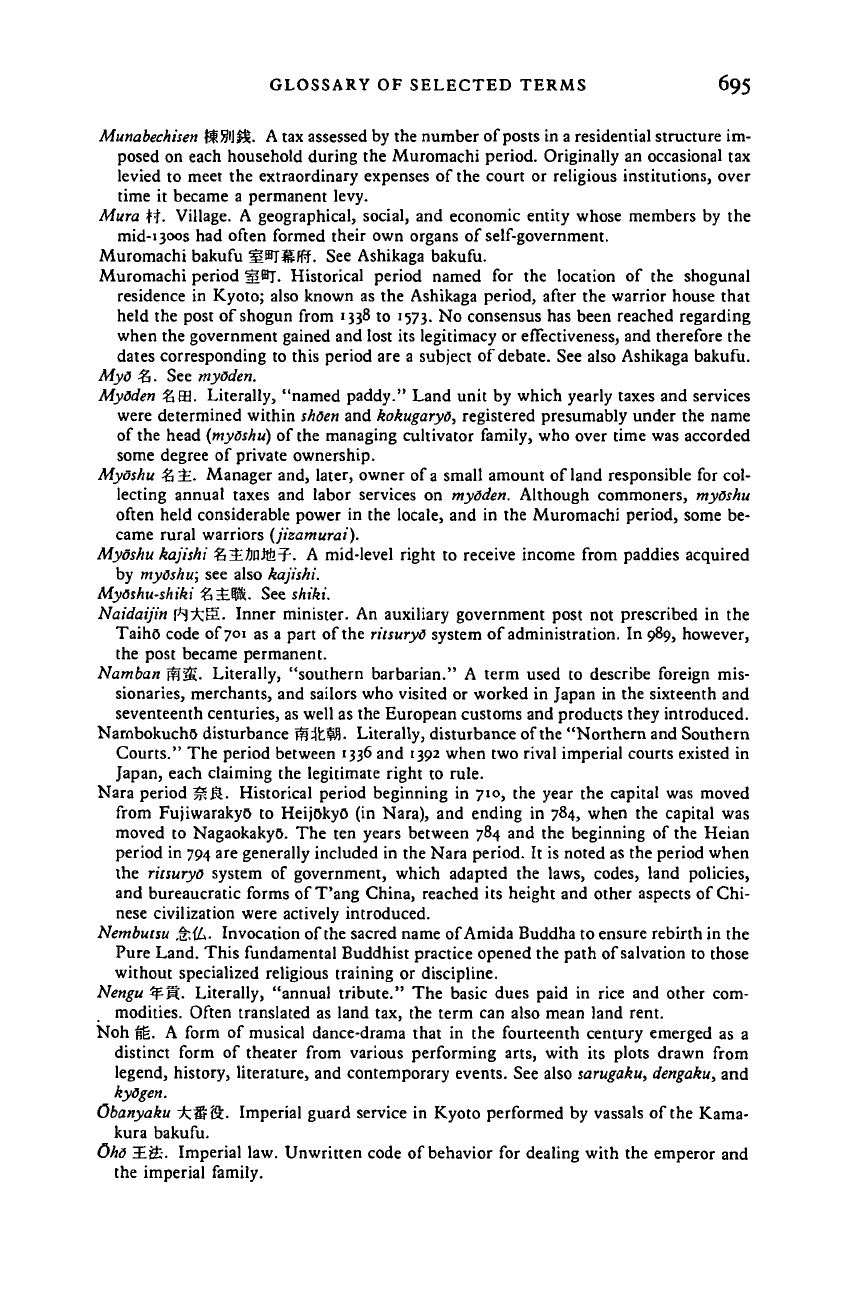
GLOSSARY OF SELECTED TERMS 695
Munabechisen
f$5>i]££. A tax assessed by the number of posts in a residential structure im-
posed on each household during the Muromachi period. Originally an occasional tax
levied to meet the extraordinary expenses of the court or religious institutions, over
time it became a permanent levy.
Mura ft. Village. A geographical, social, and economic entity whose members by the
mid-i3oos had often formed their own organs of self-government.
Muromachi bakufu ijBj^fl?. See Ashikaga bakufu.
Muromachi period HfflT. Historical period named for the location of the shogunal
residence in Kyoto; also known as the Ashikaga period, after the warrior house that
held the post of shogun from 1338 to 1573. No consensus has been reached regarding
when the government gained and lost its legitimacy or effectiveness, and therefore the
dates corresponding to this period are a subject of
debate.
See also Ashikaga bakufu.
MyO 35. See myOden.
MyOden
£ffl. Literally, "named paddy." Land unit by which yearly taxes and services
were determined within
shoen
and
kokugaryO,
registered presumably under the name
of the head (myoshu) of the managing cultivator family, who over time was accorded
some degree of private ownership.
Myoshu
3a
i. Manager and, later, owner of
a
small amount of land responsible for col-
lecting annual taxes and labor services on myOden. Although commoners, myoshu
often held considerable power in the locale, and in the Muromachi period, some be-
came rural warriors (jizamurai).
Myoshu kajishi Z^LfinitilT. A mid-level right to receive income from paddies acquired
by
myOshu;
see also kajishi.
Myoshu-shiki
%
±$L See shiki.
Naidaijin rt^riS. Inner minister. An auxiliary government post not prescribed in the
Taiho code of 701 as a part of the
ritsuryO
system of administration. In 989, however,
the post became permanent.
Namban MM- Literally, "southern barbarian." A term used to describe foreign mis-
sionaries, merchants, and sailors who visited or worked in Japan in the sixteenth and
seventeenth centuries, as well as the European customs and products they introduced.
Nambokucho disturbance
^^fc^.
Literally, disturbance of the "Northern and Southern
Courts." The period between 1336 and 1392 when two rival imperial courts existed in
Japan, each claiming the legitimate right to rule.
Nara period S&. Historical period beginning in 710, the year the capital was moved
from Fujiwarakyo to HeijOkyO (in Nara), and ending in 784, when the capital was
moved to NagaokakyO. The ten years between 784 and the beginning of the Heian
period in 794 are generally included in the Nara period. It is noted as the period when
the ritsuryO system of government, which adapted the laws, codes, land policies,
and bureaucratic forms of T'ang China, reached its height and other aspects of Chi-
nese civilization were actively introduced.
Nembutsu fciL- Invocation of the sacred name of Amida Buddha to ensure rebirth in the
Pure Land. This fundamental Buddhist practice opened the path of salvation to those
without specialized religious training or discipline.
Nengu
%-m..
Literally, "annual tribute." The basic dues paid in rice and other com-
modities. Often translated as land tax, the term can also mean land rent.
Noh
B6.
A form of musical dance-drama that in the fourteenth century emerged as a
distinct form of theater from various performing arts, with its plots drawn from
legend, history, literature, and contemporary events. See also sarugaku, dengaku, and
kydgen.
Obanyaku ^f&S. Imperial guard service in Kyoto performed by vassals of the Kama-
kura bakufu.
Oho 18;. Imperial law. Unwritten code of behavior for dealing with the emperor and
the imperial family.
Cambridge Histories Online © Cambridge University Press, 2008
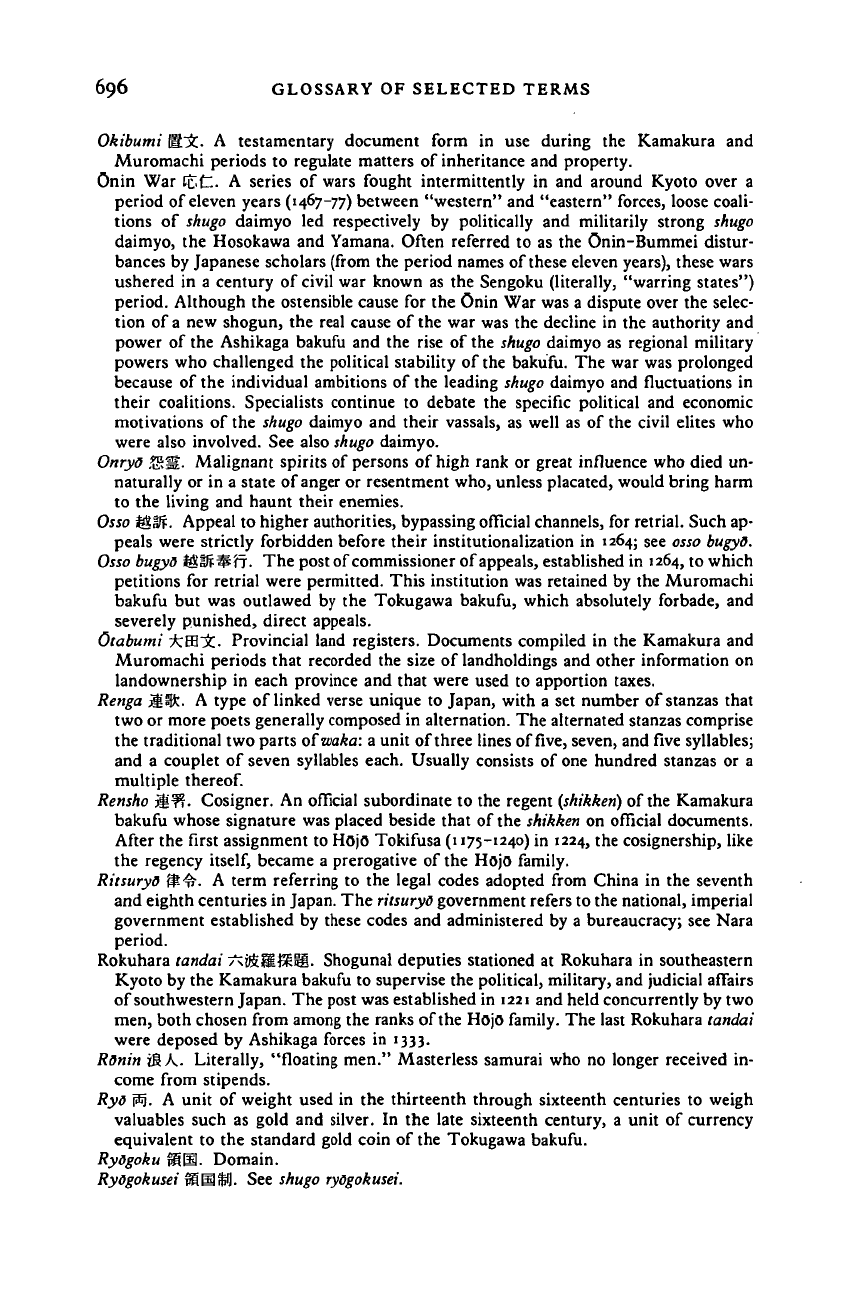
696 GLOSSARY OF SELECTED TERMS
Okibumi H
jfc-
A testamentary document form in use during the Kamakura and
Muromachi periods to regulate matters of inheritance and property.
Onin War ££t. A series of wars fought intermittently in and around Kyoto over a
period of eleven years (1467-77) between "western" and "eastern" forces, loose coali-
tions of shugo daimyo led respectively by politically and militarily strong shugo
daimyo, the Hosokawa and Yamana. Often referred to as the Onin-Bummei distur-
bances by Japanese scholars (from the period names of these eleven years), these wars
ushered in a century of civil war known as the Sengoku (literally, "warring states")
period. Although the ostensible cause for the Onin War was a dispute over the selec-
tion of a new shogun, the real cause of the war was the decline in the authority and
power of the Ashikaga bakufu and the rise of the shugo daimyo as regional military
powers who challenged the political stability of the bakufu. The war was prolonged
because of the individual ambitions of the leading shugo daimyo and fluctuations in
their coalitions. Specialists continue to debate the specific political and economic
motivations of the shugo daimyo and their vassals, as well as of the civil elites who
were also involved. See also
shugo
daimyo.
Onryo .tSfi- Malignant spirits of persons of high rank or great influence who died un-
naturally or in a state of anger or resentment who, unless placated, would bring harm
to the living and haunt their enemies.
Osso
2#SF.
Appeal to higher authorities, bypassing official channels, for retrial. Such ap-
peals were strictly forbidden before their institutionalization in 1264; see osso
bugyO.
Osso bugyO
WM^'fi. The post of commissioner of appeals, established in 1264, to which
petitions for retrial were permitted. This institution was retained by the Muromachi
bakufu but was outlawed by the Tokugawa bakufu, which absolutely forbade, and
severely punished, direct appeals.
Otabumi
-fcBl^C.
Provincial land registers. Documents compiled in the Kamakura and
Muromachi periods that recorded the size of landholdings and other information on
landownership in each province and that were used to apportion taxes.
Renga M$k- A type of linked verse unique to Japan, with a set number of stanzas that
two or more poets generally composed in alternation. The alternated stanzas comprise
the traditional two parts of waka: a unit of three lines of five, seven, and five syllables;
and a couplet of seven syllables each. Usually consists of one hundred stanzas or a
multiple
thereof.
Rensho M?i- Cosigner. An official subordinate to the regent (shikken) of the Kamakura
bakufu whose signature was placed beside that of the shikken on official documents.
After the first assignment to HojO Tokifusa (1175-1240) in 1224, the cosignership, like
the regency
itself,
became a prerogative of the HojO family.
RitsuryO W-'v- A term referring to the legal codes adopted from China in the seventh
and eighth centuries in Japan. The
ritsuryO
government refers to the national, imperial
government established by these codes and administered by a bureaucracy; see Nara
period.
Rokuhara tandai /^ScSIHB. Shogunal deputies stationed at Rokuhara in southeastern
Kyoto by the Kamakura bakufu to supervise the political, military, and judicial affairs
of southwestern Japan. The post was established in 1221 and held concurrently by two
men, both chosen from among the ranks of the HojO family. The last Rokuhara tandai
were deposed by Ashikaga forces in 1333.
Ronin i&A. Literally, "floating men." Masterless samurai who no longer received in-
come from stipends.
Ryo jSj. A unit of weight used in the thirteenth through sixteenth centuries to weigh
valuables such as gold and silver. In the late sixteenth century, a unit of currency
equivalent to the standard gold coin of the Tokugawa bakufu.
RyOgoku
RSH.
Domain.
RyOgokusei
liBS
1
). See
shugo
ryOgokusei.
Cambridge Histories Online © Cambridge University Press, 2008
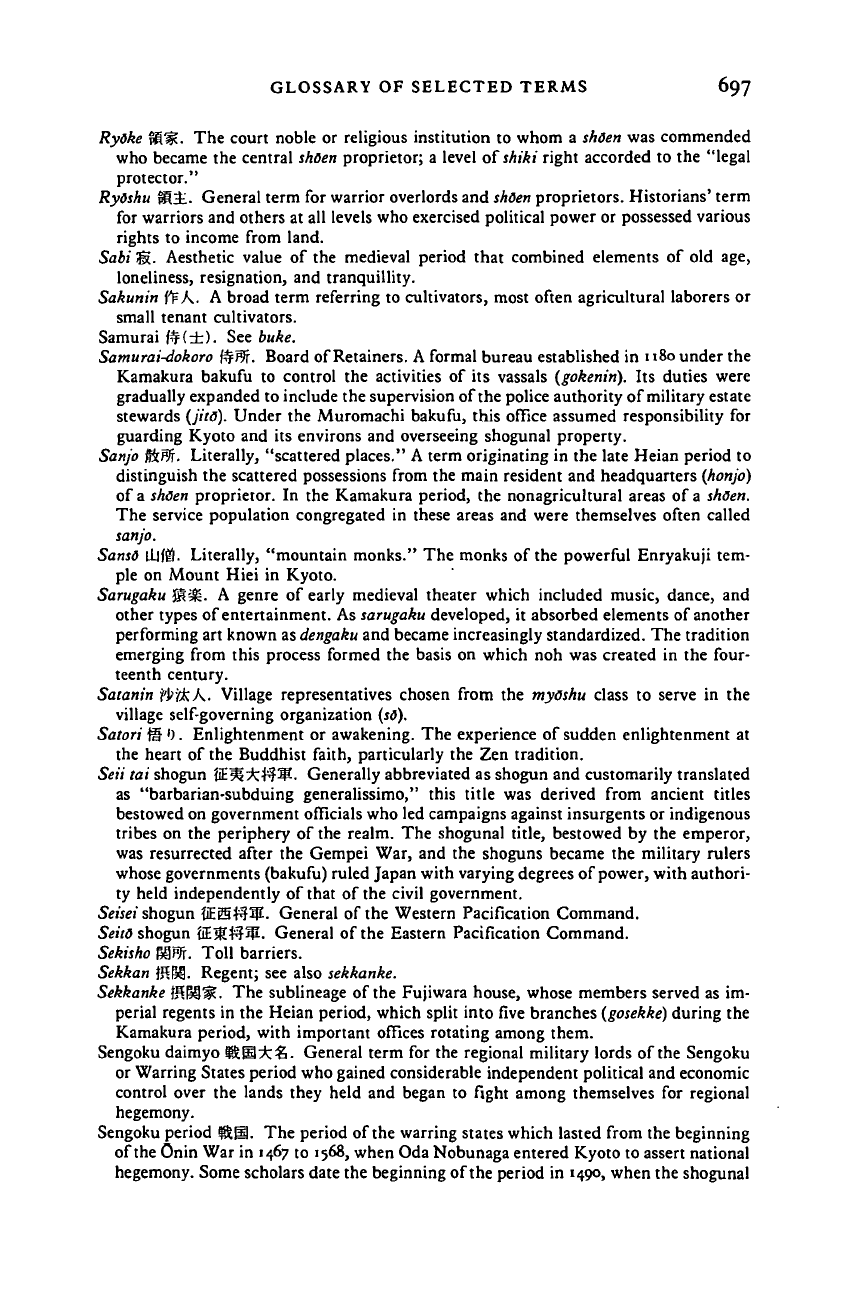
GLOSSARY OF SELECTED TERMS 697
RyOke
v&M-
The court noble or religious institution to whom a shoen was commended
who became the central
shoen
proprietor; a level of shiki right accorded to the "legal
protector."
RyOshu
PB£.
General term for warrior overlords and
shoen
proprietors. Historians' term
for warriors and others at all levels who exercised political power or possessed various
rights to income from land.
Sabi
WL.
Aesthetic value of the medieval period that combined elements of old age,
loneliness, resignation, and tranquillity.
Sakunin fFA. A broad term referring to cultivators, most often agricultural laborers or
small tenant cultivators.
Samurai f#(±). See buke.
Samurai-dokoro
f#3f.
Board of Retainers. A formal bureau established in 1180 under the
Kamakura bakufu to control the activities of its vassals
(gokeniri).
Its duties were
gradually expanded to include the supervision of the police authority of military estate
stewards (jito). Under the Muromachi bakufu, this office assumed responsibility for
guarding Kyoto and its environs and overseeing shogunal property.
Sanjo
jftfiff.
Literally, "scattered places." A term originating in the late Heian period to
distinguish the scattered possessions from the main resident and headquarters
(honjo)
of a
shoen
proprietor. In the Kamakura period, the nonagricultural areas of a shoen.
The service population congregated in these areas and were themselves often called
sanjo.
SansO
Ujfi. Literally, "mountain monks." The monks of the powerful Enryakuji tem-
ple on Mount Hiei in Kyoto.
Sarugaku
$i
:
M-
A genre of early medieval theater which included music, dance, and
other types of entertainment. As
sarugaku
developed, it absorbed elements of another
performing art known as
dengaku
and became increasingly standardized. The tradition
emerging from this process formed the basis on which noh was created in the four-
teenth century.
Satanin Wtkh. Village representatives chosen from the myoshu class to serve in the
village self-governing organization (so).
Satori fii 0. Enlightenment or awakening. The experience of sudden enlightenment at
the heart of the Buddhist faith, particularly the Zen tradition.
Sett
tax
shogun
W%~k.WW-.
Generally abbreviated as shogun and customarily translated
as "barbarian-subduing generalissimo," this title was derived from ancient titles
bestowed on government officials who led campaigns against insurgents or indigenous
tribes on the periphery of the realm. The shogunal title, bestowed by the emperor,
was resurrected after the Gempei War, and the shoguns became the military rulers
whose governments (bakufu) ruled Japan with varying degrees of power, with authori-
ty held independently of that of the civil government.
Seisei
shogun
WMffiW-
General of the Western Pacification Command.
SeitO
shogun fiE^t?^. General of the Eastern Pacification Command.
Sekisho
KlMf.
Toll barriers.
Sekkan ffilMJ. Regent; see also sekkanke.
Sekkanke }ff BU^. The sublineage of the Fujiwara house, whose members served as im-
perial regents in the Heian period, which split into five branches
(gosekke)
during the
Kamakura period, with important offices rotating among them.
Sengoku daimyo 9£|B:*:€. General term for the regional military lords of the Sengoku
or Warring States period who gained considerable independent political and economic
control over the lands they held and began to fight among themselves for regional
hegemony.
Sengoku period ©B. The period of the warring states which lasted from the beginning
of the Onin War in 1467 to 1568, when Oda Nobunaga entered Kyoto to assert national
hegemony. Some scholars date the beginning of the period in 1490, when the shogunal
Cambridge Histories Online © Cambridge University Press, 2008
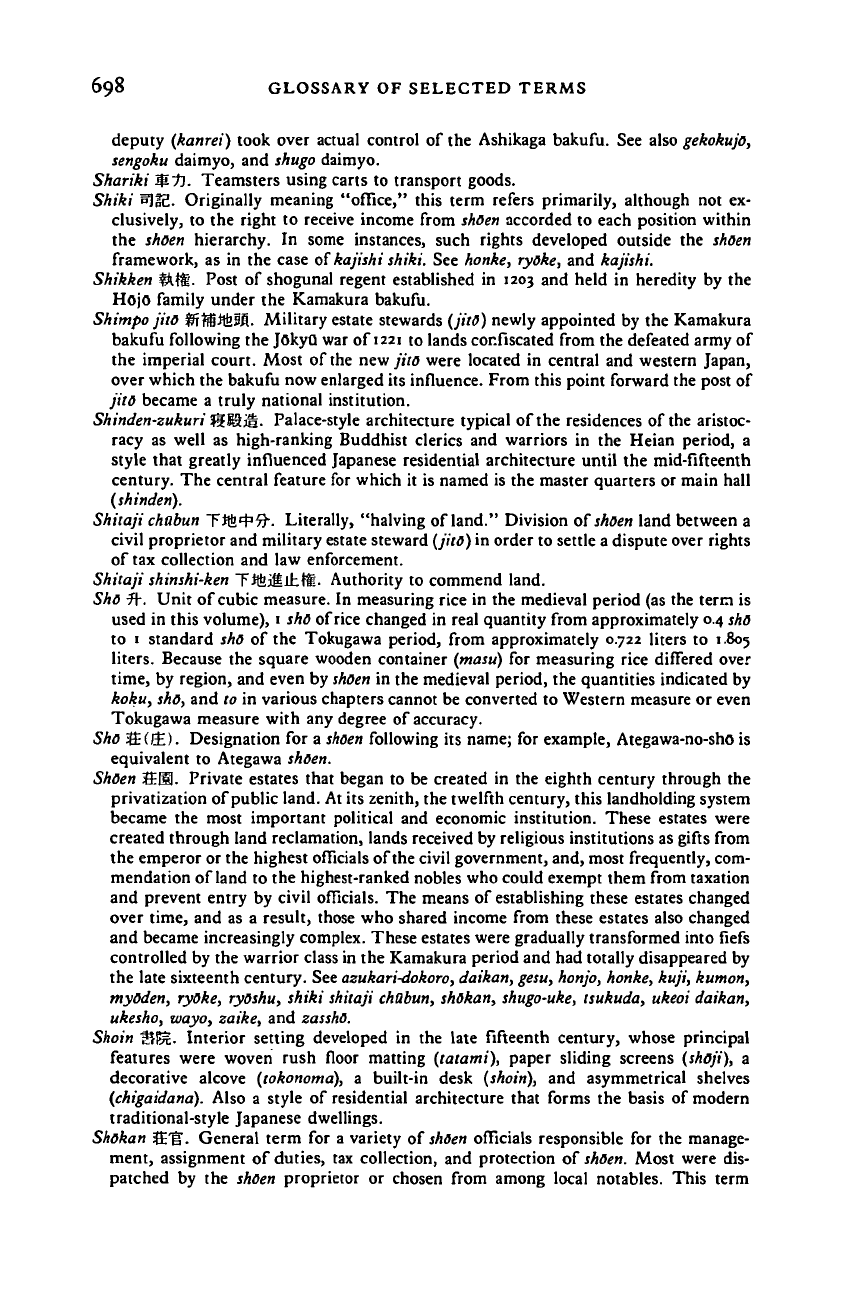
698 GLOSSARY OF SELECTED TERMS
deputy (kanrei) took over actual control of the Ashikaga bakufu. See also gekokujo,
sengoku daimyo, and shugo daimyo.
Shariki
%~t).
Teamsters using carts to transport goods.
Shiki p]|2. Originally meaning "office," this term refers primarily, although not ex-
clusively, to the right to receive income from
shoen
accorded to each position within
the shoen hierarchy. In some instances, such rights developed outside the shoen
framework, as in the case of kajishi shiki. See honke, ryoke, and kajishi.
Shikken Hff. Post of shogunal regent established in 1203 and held in heredity by the
HojO family under the Kamakura bakufu.
Shimpo jito ffffiflfesfi. Military estate stewards (jitO) newly appointed by the Kamakura
bakufu following the Jokyu war of
1221
to lands confiscated from the defeated army of
the imperial court. Most of the new jito were located in central and western Japan,
over which the bakufu now enlarged its influence. From this point forward the post of
jito became a truly national institution.
Shinden-zukuri fiESSia. Palace-style architecture typical of the residences of the aristoc-
racy as well as high-ranking Buddhist clerics and warriors in the Heian period, a
style that greatly influenced Japanese residential architecture until the mid-fifteenth
century. The central feature for which it is named is the master quarters or main hall
(shinden).
Shitaji
chabun
TJft4
1
^". Literally, "halving of land." Division of
shoen
land between a
civil proprietor and military estate steward (jito) in order to settle a dispute over rights
of tax collection and law enforcement.
Shitaji
shinshi-ken
TJ&iSlttfi. Authority to commend land.
Sho fh Unit of cubic measure. In measuring rice in the medieval period (as the term is
used in this volume),
1
sho of rice changed in real quantity from approximately 0.4
sho
to 1 standard sho of the Tokugawa period, from approximately 0.722 liters to
1
805
liters.
Because the square wooden container (masu) for measuring rice differed over
time,
by region, and even by
shoen
in the medieval period, the quantities indicated by
koku, sho, and to in various chapters cannot be converted to Western measure or even
Tokugawa measure with any degree of accuracy.
Sho ;££()£). Designation for a
shoen
following its name; for example, Ategawa-no-sho is
equivalent to Ategawa shoen.
Shoen JEH. Private estates that began to be created in the eighth century through the
privatization of public land. At its zenith, the twelfth century, this landholding system
became the most important political and economic institution. These estates were
created through land reclamation, lands received by religious institutions as gifts from
the emperor or the highest officials of the civil government, and, most frequently, com-
mendation of land to the highest-ranked nobles who could exempt them from taxation
and prevent entry by civil officials. The means of establishing these estates changed
over time, and as a result, those who shared income from these estates also changed
and became increasingly complex. These estates were gradually transformed into fiefs
controlled by the warrior class in the Kamakura period and had totally disappeared by
the late sixteenth century. See
azukari-dokoro,
daikan,
gesu,
honjo,
honke, kuji, kumon,
tnyOden,
ryoke,
ryOshu,
shiki shitaji
chubun,
shokan,
shugo-uke,
tsukuda, ukeoi daikan,
ukesho, wayo, zaike, and zassho.
Shoin
Wl$n.
Interior setting developed in the late fifteenth century, whose principal
features were woven rush floor matting (tatami), paper sliding screens (shoji), a
decorative alcove (tokonoma), a built-in desk (shoin), and asymmetrical shelves
(chigaidana). Also a style of residential architecture that forms the basis of modern
traditional-style Japanese dwellings.
Shokan 8rf. General term for a variety of
shoen
officials responsible for the manage-
ment, assignment of duties, tax collection, and protection of
shoen.
Most were dis-
patched by the shoen proprietor or chosen from among local notables. This term
Cambridge Histories Online © Cambridge University Press, 2008
